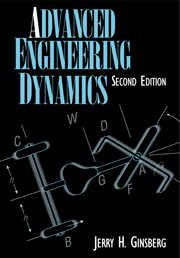Book contents
- Frontmatter
- Contents
- Preface
- Chapter 1 Basic Considerations
- Chapter 2 Particle Kinematics
- Chapter 3 Relative Motion
- Chapter 4 Kinematics of Rigid Bodies
- Chapter 5 Newtonian Kinetics of a Rigid Body
- Chapter 6 Introduction to Analytical Mechanics
- Chapter 7 Further Concepts in Analytical Mechanics
- Chapter 8 Gyroscopic Effects
- Appendix Centroidal Inertia Properties
- Answers to Even-Numbered Problems
- Index
Chapter 8 - Gyroscopic Effects
Published online by Cambridge University Press: 05 June 2012
- Frontmatter
- Contents
- Preface
- Chapter 1 Basic Considerations
- Chapter 2 Particle Kinematics
- Chapter 3 Relative Motion
- Chapter 4 Kinematics of Rigid Bodies
- Chapter 5 Newtonian Kinetics of a Rigid Body
- Chapter 6 Introduction to Analytical Mechanics
- Chapter 7 Further Concepts in Analytical Mechanics
- Chapter 8 Gyroscopic Effects
- Appendix Centroidal Inertia Properties
- Answers to Even-Numbered Problems
- Index
Summary
Our emphasis thus far has been on development of basic principles for treating the kinematics and kinetics of rigid-body motion. Regardless of whether we employed a Newtonian or Lagrangian formulation, it was usually necessary to account for constraints associated with the way in which the system is supported. Sometimes the goal was to characterize the force system required to produce a specified motion, as when the reactions must be evaluated. Other situations required the determination of conditions that are satisfied during the motion, as typified by the task of deriving differential equations of motion. In this chapter we will formulate and solve the equations of motion governing the rotational motion of a rigid body. Because the angular momentum in spatial motion is usually not aligned with the instantaneous axis of rotation, a portion of the rotational effect does not coincide with that axis. Such phenomena are exploited in gyroscopes, whose theory will be introduced here. However, we may learn much about the nature of dynamical responses by beginning with studies of simpler, yet more common, systems that display comparable effects.
Free Motion
One of the first types of spatial motion treated in basic physics and engineering courses on mechanics is projectile motion, whose study is devoted to the determination of the motion of the center of mass. In contrast, the manner in which the body rotates about its center of mass is seldom discussed in a fundamental course.
Information
- Type
- Chapter
- Information
- Advanced Engineering Dynamics , pp. 389 - 440Publisher: Cambridge University PressPrint publication year: 1995
